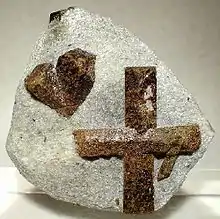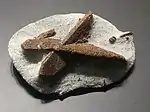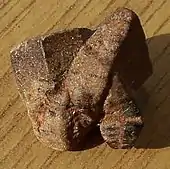Staurolite
Staurolite is a reddish brown to black, mostly opaque, nesosilicate mineral with a white streak. It crystallizes in the monoclinic crystal system, has a Mohs hardness of 7 to 7.5 and the chemical formula: Fe2+2Al9O6(SiO4)4(O,OH)2. Magnesium, zinc and manganese substitute in the iron site and trivalent iron can substitute for aluminium.[1]
| Staurolite | |
|---|---|
 Staurolite from Pestsovye Keivy, Keivy Mountains, Kola Peninsula, Murmanskaja Oblast', Northern Region, Russia, 2.5 x 2.2 x 1 cm | |
| General | |
| Category | Nesosilicate |
| Formula (repeating unit) | Fe2+2Al9O6(SiO4)4(O,OH)2[1] |
| IMA symbol | St[2] |
| Strunz classification | 9.AF.30 |
| Crystal system | Monoclinic |
| Crystal class | Prismatic (2/m) (same H-M symbol) |
| Space group | C2/m |
| Unit cell | a = 7.86 Å, b = 16.6 Å c = 5.65 Å; β = 90.45°; Z = 2 |
| Identification | |
| Color | Dark reddish brown to blackish brown, yellowish brown, rarely blue; pale golden yellow in thin section |
| Crystal habit | Commonly in prismatic crystals |
| Twinning | Commonly as 60° twins, less common as 90° cruciform twins |
| Cleavage | Distinct on {010} |
| Fracture | Subconchoidal |
| Tenacity | Brittle |
| Mohs scale hardness | 7 - 7.5 |
| Luster | Subvitreous to resinous |
| Streak | White to grayish |
| Diaphaneity | Transparent to opaque |
| Specific gravity | 3.74 - 3.83 meas. 3.686 calc. |
| Optical properties | Biaxial (+) |
| Refractive index | nα = 1.736 - 1.747 nβ = 1.740 - 1.754 nγ = 1.745 - 1.762 |
| Birefringence | δ = 0.009 - 0.015 |
| Pleochroism | X = colorless; Y = pale yellow; Z = golden yellow |
| 2V angle | Measured: 88°, Calculated: 84° to 88° |
| Dispersion | r > v; weak |
| References | [3][4][5] |
Properties

Staurolite often occurs twinned in a characteristic cross-shape, called cruciform penetration twinning.[6] In handsamples, macroscopically visible staurolite crystals are of prismatic shape. The mineral often forms porphyroblasts.
In thin sections staurolite is commonly twinned and shows lower first order birefringence similar to quartz, with the twinning displaying optical continuity. It can be identified in metamorphic rocks by its swiss cheese appearance (with poikilitic quartz) and often mantled porphyroblastic character.
Name
The name is derived from the Greek, stauros for cross and lithos for stone in reference to the common twinning.
Occurrence

Staurolite is a regional metamorphic mineral of intermediate to high grade. It occurs with almandine garnet, micas, kyanite; as well as albite, biotite, and sillimanite in gneiss and schist of regional metamorphic rocks.[7]
It is the official state mineral of the U.S. state of Georgia and is also to be found in the Lepontine Alps in Switzerland.
Staurolite is most commonly found in Fannin County, Georgia.[8] It is also found in Fairy Stone State Park in Patrick County, Virginia. The park is named for a local name for staurolite from a legend in the area.[9] Samples are also found in Island Park, Idaho, near Henrys Lake; Taos, New Mexico; near Blanchard Dam in Minnesota; and Selbu, Norway.
Use
Staurolite is one of the index minerals that are used to estimate the temperature, depth, and pressure at which a rock undergoes metamorphism.
References
- Klein, Cornelis and Cornelius S. Hurlbut, Jr., Manual of Mineralogy, Wiley. 20th ed., 1985, p. 382 - 3 ISBN 0-471-80580-7
- Warr, L.N. (2021). "IMA–CNMNC approved mineral symbols". Mineralogical Magazine. 85 (3): 291–320. Bibcode:2021MinM...85..291W. doi:10.1180/mgm.2021.43. S2CID 235729616.
- http://rruff.geo.arizona.edu/doclib/hom/staurolite.pdf Handbook of Mineralogy
- http://www.mindat.org/show.php?id=3753&ld=1&pho= Mindat.org
- http://webmineral.com/data/Staurolite.shtml Webmineral data
- Simpson, B. (1983). Rock & Minerals. Elsevier. p. 41. ISBN 9780080984117. Retrieved 17 November 2017.
- The Audubon Society Field Guide to North American Rocks and Minerals, Chesterman and knopf.
- Fannin County Archives
- Virginia State Parks